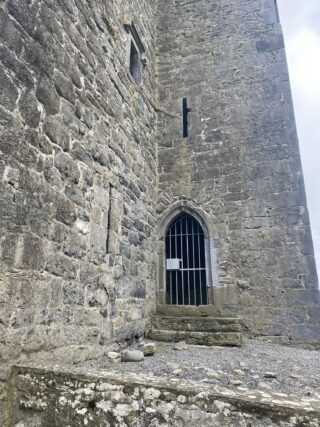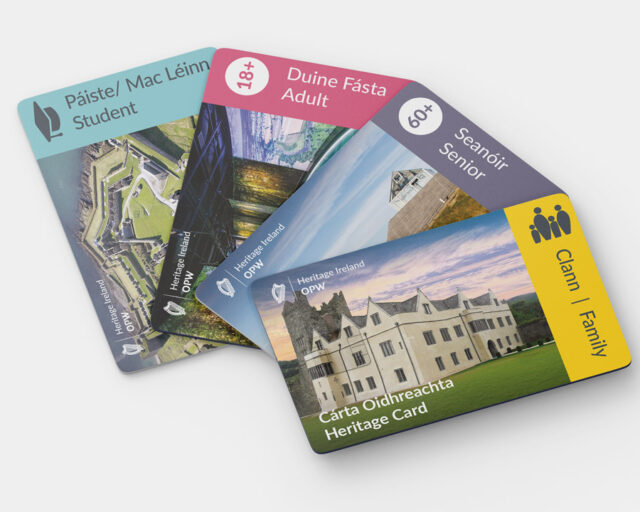Notice
Gleninagh Castle is a state-owned National Monument in the care of the Office of Public Works
*Please be aware this monument is located in a farming field*
WARNING: It should be noted that these sites are unguided and a level of care and caution should be maintained during all stages of your visit. The Office Of Public Works (OPW) will not be held responsible for any damages, injuries, or losses that occur
Gleninagh Castle
The history of Gleninagh Castle, a sixteenth-century tower house located in the far north of the Burren in County Clare, gives an interesting insight into the political, economic and social history of that region in the medieval and early modern periods. Tower houses were built for residential and defensive purposes by powerful Gaelic families- in this case the O'Loughlens.
The O’Loughlens were descendants of the Corcomrad clan, and despite the dominance of the O’Brien Kings of Thomond in Clare from the 12th to the 16th centuries, the O’Loughlens owned and controlled large tracts of land in the barony of Burren. In medieval times the O’Loughlens styled themselves ‘Kings of Burren’, and in 1268 King Conor Roe O’Brien was killed by the O’Loughlens in what appears to have been an inter clan battle.
In the medieval period there was quite a lot of economic activity in the Burren. There is evidence that there was a significant wool-processing industry as well as dairy farming. The potato crop thrived in the acidic soil. The medieval and early modern periods in Clare were characterised by power struggles between various Gaelic clans and occasionally outsiders such as the Norman De Clares.
By the time Gleninagh castle was built, the O’Briens were firmly established as Kings of Thomond. The other prominent Gaelic families in Clare, such as the O’Loughlens, McClancys and McNamaras functioned as subordinate clans to the O’Briens, but the O’Loughlens in particular remained a powerful force in north Clare, and they owned some of the best land in the Burren area.
Gleninagh castle, a large, imposing tower house, made a strong statement about the status of the O’Loughlen family. The defensive features reflected the warfare and instability brought about by the various power struggles in medieval Clare. Gleninagh castle was one of a number of tower houses built in the Burren during that era, but its size and unusual ‘L’ shape meant that it stood out. It was the residence and stronghold of the O’Loughlens until well into the sixteenth century. By that time, the Gaelic Kings and Lords had lost their dominance as the English crown tightened its grip on Ireland. Many Gaelic nobles, including the O’Briens, submitted to the Crown and the Protestant religion and in return were allowed to keep their lands.
Some of the O’Loughlen family, however, remained Catholic. Over the tumultuous next few centuries Gleninagh Castle had a number of different occupants but in the nineteenth century the O’Loughlens were living at Gleninagh again. The penal laws that effectively outlawed Catholicism were loosened by this time, and a member of the O’Loughlen family, the lawyer Sir Michael O’Loughlen, was the first Catholic in Ireland to gain the office of Master of the Rolls.
In 1842, the journalist Thomas L. Cooke wrote about his travels in the Burren, and he described Gleninagh Castle:
“Passing along a pathway, over green fields, from the church towards the sea-coast, the tourist arrives at Gleninagh Castle, once a handsome and stately building, but which is now thatched with straw, and used as a barn by Mr. Blood, its proprietor.”
Protect our Past - Click here to read about the importance of protecting our country’s unique heritage sites
This national monument is protected in accordance with the National Monuments Acts 1930 to 2014
Gallery
Nearby sites to visit
Dún Aonghasa – Ancient Stone Fort
One of western Europe’s most magnificent stone forts
Approx. 37.4 km from Gleninagh Castle
Ionad Cultúrtha an Phiarsaigh Conamara- Pearse’s Cottage and Visitor Centre
A cottage steeped in revolutionary history and Gaelic culture
Approx. 39.1 km from Gleninagh Castle
Askeaton Castle
A ruined stronghold of the earls of Desmond
Approx. 61.7 km from Gleninagh Castle




